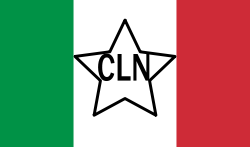National Liberation Committee

The National Liberation Committee (Italian: Comitato di Liberazione Nazionale, CLN) was a political umbrella organization and the main representative of the Italian resistance movement fighting against the German occupation of Italy in the aftermath of the armistice of Cassibile. It was a multi-party entity, whose members were united by their anti-fascism.
It was formed on 9 September 1943, following Italy's surrender to the Allies and Germany's invasion of the country. The member parties were the Italian Communist Party, the Italian Socialist Party, the Action Party, Christian Democracy, the Labour Democratic Party, and the Italian Liberal Party. With the backing of the Royal government and the Allied powers, CLN gained official recognition as the representative of the Italian resistance movement, and had several leaders operating underground in German-occupied Italy.
The partisan formations controlled by the CLN were primarily divided between three main groups, Communist Garibaldi Brigades, the Action Party's Justice and Freedom Brigades, and Socialist "Matteotti" Brigades. Smaller groups included Catholic and monarchist partisans. There were partisan units not represented in the CLN, including the Brigata Maiella and anarchist, republican and Trotskyist formations.
The CLN led the governments of Italy from the liberation of Rome in June 1944 until the first post-war general election in 1946.
See also
- National Liberation Committee for Northern Italy
- Italian Resistance